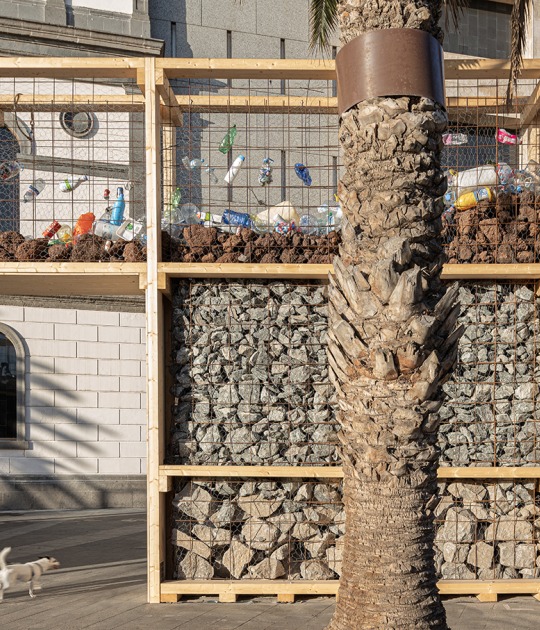The view of the Arena evokes the old Népstadion. The nostalgic feeling is enhanced by the fact that the concrete from the demolished building has been reused in the foundations and walls of the new one. The preserved and refurbished old tower building has become a museum, the Puskás Exhibition Centre.
Description of project by Közti
Inaugurated at the end of 2019, the new Puskás Arena located in Budapest (Hungary) is the result of the combination of architecture, engineering, and technology. It has been designed to host sporting events and events of any kind and has a capacity of 67,215 spectators for football matches and 78,000 for concerts. It is located in the area where the old Nepstadion stadium, built between 1948 and 1953, was located. The architect in charge of the project György Skardelli, from the Közti studio, had the premise of preserving the distinctive character of the original building while creating a modern sports facility capable of meeting the most advanced design expectations and meeting the requirements necessary to achieve 5-star ratings from FIFA and UEFA.
In addition to the stands and areas for athletes, such as 11 changing rooms, the stadium also houses administrative areas, an area for holding events such as conferences or banquets, and 88 boxes with exclusive service. Like its predecessor sports equipment, it is also named in honor of the former Hungarian National Team star and legendary soccer player Ferenc Puskás, who in Spain was known as Pancho while playing for Real Madrid FC. The new stadium occupies 22nd in the ranking of the largest stadiums in Europe and this year, after months of mandatory stoppage due to the health emergency, it will host the final of the European Super Cup organized by UEFA in September 24.
A concrete building with a metal envelope
The maximum height of the building is 52.26 m, and it has a length of 316.5 m. The stadium grandstand has been built on four levels and the roof covers 57,398 m2 of the building, leaving only the playing area open to the sky. Those who know the old equipment will find similarities in the access system to the grandstands, the stair pylons, and the wide lower walkway. But what has been preserved is the old tower, which has been restored to become a museum and Puskás exhibition center. Of course, the concrete obtained after the demolition of the old building has been used for the foundations and build the walls of the new one.
To raise the grandstand, precast concrete pieces have been used that have been reinforced with prestressed and structural steel. The process included the installation of 38 monolithic pillars of variable geometry, 30 of which are visible from the outside creating rhythm in the stadium architecture. In contrast to the forcefulness of these huge pillars, the stadium façade was covered with a stainless steel skin. It is a metallic mesh with a total surface area of 19,500 m2 and has been designed and manufactured by the Codina Architectural company, specialized in the production of metallic fabrics for architectural and interior and exterior design projects.
The model chosen was the Eiffel 20100 stainless steel wire mesh with a frosted (engraved) finish that was manufactured in six months. Its application has consisted of 229 panels 4 m wide, 29 m long, and weighing almost 100 kg each. The chosen fixing system is the TF-60, which has been adapted to the sports project, and which consists of placing a rod inside the first and last spiral of the mesh, to anchor the mesh on the desired surface.
With the metallic mesh of Codina Architectural, it has been possible to configure an impressive and dynamic façade, since the metallic fabric manages to adapt to the architecture of the stadium, giving it volume and shape. Besides, it allows obtaining different degrees of transparency depending on the inclination of the light and the perspective of the observer, making the metallic mesh appear sometimes opaque or other semi-transparent. At the same time, during the night, he participates without interfering in the architectural lighting project that projects the stadium to the outside. Finally, this type of solution also contributes to acoustic attenuation, serves as a solar protection element to improve energy efficiency, and, finally, acts as a filter for wind and rain.
Codina Architectural Solutions
- EIFFEL 20100 Architectural Mesh
Rolled turns joined together by a wavy or straight rod. The EIFFEL 20100 architectural mesh model is one of the best products in the Eiffel series for covering large facades. The possibility of producing large widths allows us to cover large areas with fewer panels helping to control installation time and budget. The EIFFEL 20100 design was created to balance the weight of the mesh with the perfect opacity to let light pass through. CODINA produces multiple material finishes and color tones for this model, allowing the model to adapt to any project.
- Fixing TF - 60
The fixing is made up of a rod inserted inside the spiral, inserting fixing sockets. This fixing allows the panel to be supported from the top, bottom, and any intermediate area. All in AISI 316 material.





































